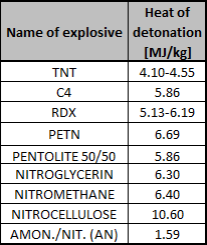- 1,292
- 346
Question: "Why isn't Brode's Method talked about on this site?"
Brode's Method is an actual formula used to calculate the energy from explosions:

Where:
E is the explosion energy in joules
P1 is starting or ambient pressure (1 atm; would typically be 101,325 pascals unless otherwise specified)
P2 is the burst pressure (We typically use 20 psi, so 137,895 pascals)
V is the volume of the gas (Would typically be a hemisphere)
γ is the heat capacity ratio of the gas in question. (1.4 for air)
One more question on the side:
For explosions on the ground we use the following formula:
W = R^3*((27136*P+8649)^(1/2)/13568-93/13568)^2
But, what exactly did this formula even come from? I cannot find any kind of reference to it at all, nor do I see any links or explanations to exactly what this formula even is.
Brode's Method is an actual formula used to calculate the energy from explosions:

Where:
E is the explosion energy in joules
P1 is starting or ambient pressure (1 atm; would typically be 101,325 pascals unless otherwise specified)
P2 is the burst pressure (We typically use 20 psi, so 137,895 pascals)
V is the volume of the gas (Would typically be a hemisphere)
γ is the heat capacity ratio of the gas in question. (1.4 for air)
One more question on the side:
For explosions on the ground we use the following formula:
W = R^3*((27136*P+8649)^(1/2)/13568-93/13568)^2
But, what exactly did this formula even come from? I cannot find any kind of reference to it at all, nor do I see any links or explanations to exactly what this formula even is.

